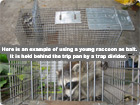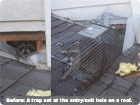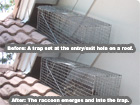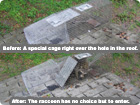NEED LOCAL HELP? We have wildlife removal professionals servicing 95% of the USA. Click here to
hire a local raccoon removal expert in your home town. Updated 2018. But read the below advice first!
Do Traps Work? Yes. But it has to be the right type of trap, and it has to be used in the right way. There are dozens of types of raccoon
traps, some live traps, some lethal traps, even some exclusion devices that don't trap at all. I’ll quickly discuss the various types of traps, but before I do, I must point out the single most important
thing to keep in mind regarding raccoons in the attic, and the reason a raccoon in the attic is not such a simple matter.
Here is my info about what type of raccoon bait to use, and if you do catch one, read about raccoon relocation tactics.
Click below photos for more examples of trap sets by professionals:
THE MAJORITY OF THE TIME, A RACCOON IN AN ATTIC IS A FEMALE WITH YOUNG – Yes, the majority of the time, about 80% of cases of any raccoon in an attic, there’s a litter of 3-5 baby raccoon pups. The most common reason for a raccoon to enter an attic and choose to live there is the case of a female who needs a safe place to give birth and raise its babies. The presence of these young complicates the matter of removing raccoons, because if you trap and remove the adult female, the young are left behind. I’ve seen several dozen such cases: a homeowner uses some sort of trap to remove the mom, and then the homeowner starts to hear the scratching and squealing of the starving young, and they call me. If you do trap a raccoon, check for nipples! If you can see them, you’ve got babies up there, and they’ve got to be found and removed, and it’s often no easy task.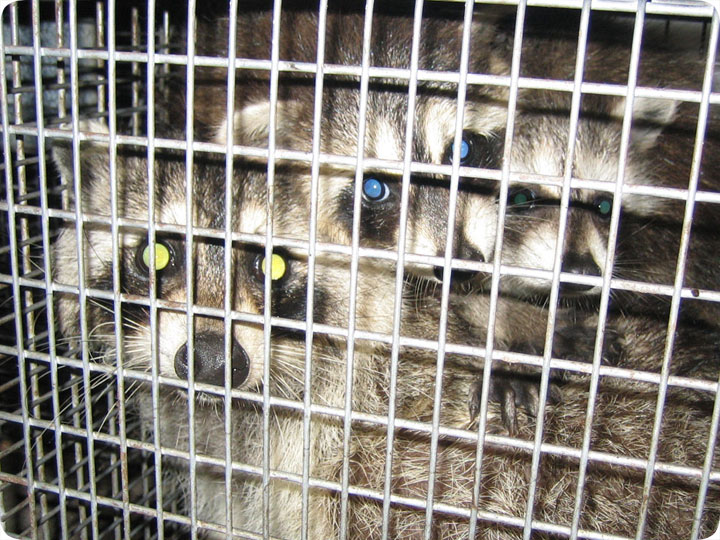
Types of Traps – Here’s an analysis of types of raccoon traps:
Body Grip Traps – These are lethal traps, kind of like giant rat traps. There are several types, with the most common the double spring-loaded connibear traps. These types of traps are used mostly by olde-time fur trappers. The basic gist is that they are set over an area a raccoon will move, such as over a hole leading into an attic, and when sprung, snap down on the animal and kill it via choking or crushing. They are dangerous and difficult to use, and very few people, other than old fur trappers, would use them. If you hire a wildlife trapper who uses this type of trap, please be aware that there are better alternatives.
Paw Hold Traps: These types of traps are also only really used by trappers, often fur trappers, some of whom perform nuisance wildlife removal services. There are several different types of paw hold traps. These traps work by clamping down on an animal’s paw and holding it. It’s basically a small snapping clamp device staked down in some fashion. When the trapper catches a raccoon with this type of trap, he usually then kills it via shooting. Again, there are better trapping alternatives.
Live Cage Trap: This is by far the most common type of trap used by wildlife control companies and do-it-yourself homeowners. There are many different makes and models of cage trap. Cage traps are generally large metal cages into which the raccoon enters, lured in by food. Near the back of the cage is a trip pan. When the raccoon steps on the pan, it triggers the trap door shut, and the animal is trapped inside, alive. Some of these traps are made from different materials, such as solid-walled plastic or other materials. Most are made from steel bars. A cage trap needs to be large enough to hold the raccoon, and most raccoon-size cage traps are at least 32 inches long and 12 inches high and wide. If it’s too small, the animal won’t fit inside, or may trigger the trip pan, but not allow clearance for the door to shut all the way. The most commonly sold brand in the United States is the Havahart brand, which is sometimes sold in large hardware stores. The fact that it’s readily sold to the public often leads people to believe that they can just go out and trap animals. However, there are many very important considerations when raccoon trapping that one should consider before just buying a trap and setting it.
If you want to purchase your own traps, I have written an analysis of several models of live cage traps, with photos, on my raccoon trapping supplies page, which also includes photos and info about one-way exclusion doors, nose cones, etc.
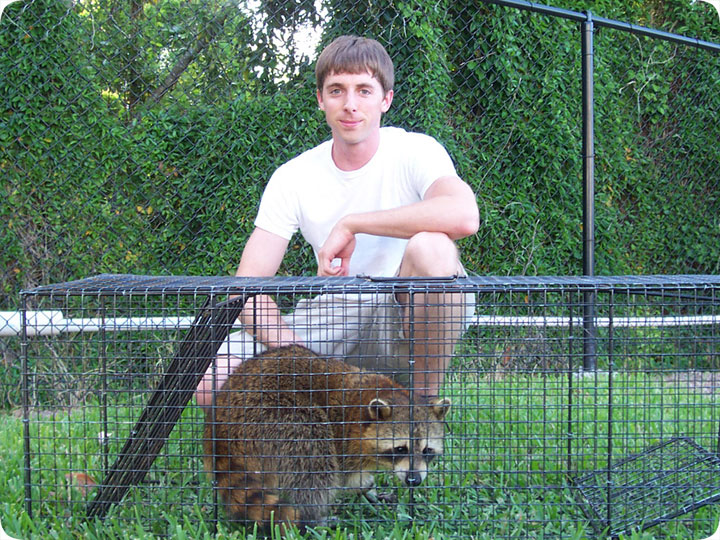
1) How To Target The Correct Animal? One problem amateurs encounter is that they set a trap and catch every other animal in the neighborhood, instead of the animal that is causing the problem. I’ve been to many homes in which homeowners have set their own traps and rattled off lists like, “I’ve caught two skunks, an opossum, and a stray cat, but I can’t get that darn raccoon!”. This is a problem because these unintentional catches can be harmful to the animals – it’s always stressful to get caught, if not lethal, even with “humane” traps (see below). In addition, I’ve seen several cases in which homeowners have caught neighborhood pet cats. One of these incidents resulted in a lawsuit when a pet cat died from exhaustion/dehydration from being carelessly left in a cage trap for two days. An expert wildlife removal professional will know how to target the animal properly. I never set cage traps outside on the ground if there’s a raccoon in the attic (see point 6) This may catch the right raccoon, but there’s a good chance that it won’t, and will cause other problems.
2) What if I Can’t Catch it at All? Failure to catch the animal commonly arises amongst people who don’t know much about trapping. So many important and subtle nuances go into successful trapping. The right type of trap must be set (at least 32 inches long). It must have no defects. It must have the correct pan tension. It must be flush to the ground with no wobble. It must be set in the animal’s path of travel or exploration.
3) What Type of Bait Should I Use? This factor isn’t nearly as important as other factors in terms of success. Raccoons are omnivores and will eat almost anything. That said, you should not use meat-based baits, which are more likely to attract opossums, skunks, and of course, cats. Better baits include white bread or marshmallows. A trail of bait should lead from out of the trap into the trap to acclimate the animal to eating the bait and lure it in for more. Most of the bait should be set in the very back of the trap behind the trip pan. But in the case of raccoons in the attic, you should not be trapping with bait at all (see point 6)
4) What Types Of Accidents Can Occur With Trapping? I’ve seen it all. From the above mentioned case of killing a pet cat, to several cases of killing innocent wild animals. Many people simply set the trap in a convenient or random spot. But what if that spot is exposed to the sun, and you leave the animal out all day I direct sunlight – it might die of dehydration or heat stroke, which I’ve heard has happened. I’ve seen cases in which a trap was set next to a swimming pool, and the raccoon pulled itself in and drowned, and I was called to fish it out of the water and cremate it. I’ve seen cases in which raccoons have reached through the bars of the cage and ripped up screened doors and pool enclosures, pulled up electrical wires, and more. An astute trapper keeps his eyes open for all of these dangers and sets the traps properly and secure in a safe place. In fact, when I do trap, it’s often with cages bolted to the roof, in order to get the target animal. But once again, regular trapping is not the answer with raccoons living in the attic (see point 6).
5) Is it Legal for me to Trap the Raccoon? In most states, no. Or, if it is legal, you must kill and dispose of the animal on your property at the time of capture. Are you able and willing to do so? It is not legal, in almost all states, to trap a raccoon, stick it in the trunk of your car, drive it off to the woods, and release it. Check the regulations posted by your state’s department of wildlife (or fish & game) and you will see that it is illegal to do so if you are not a licensed wildlife control professional. I've found a good wildlife removal directory if you need to find a local pro in your area.
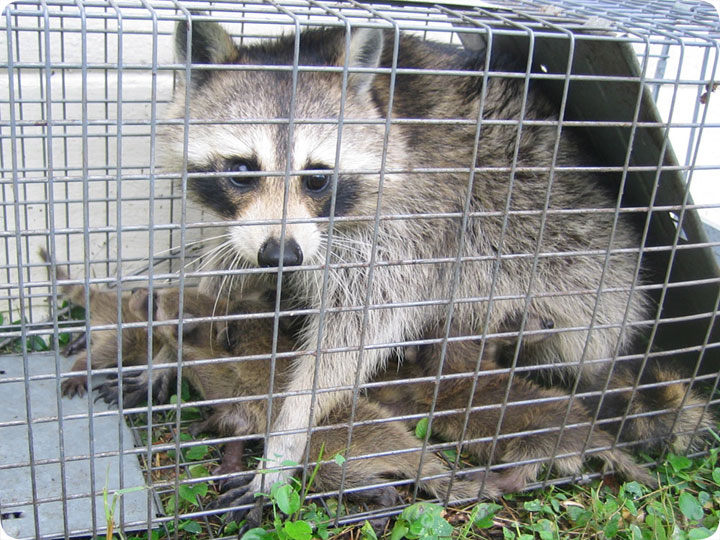
6) Okay then, I Want to Avoid the Law and do it Myself – How? First, you go into the attic and find the babies! That’s right, you explore the whole attic and remove the young by hand. Be careful, there’s a protective and ferocious mother raccoon nearby! Actually, I’ve removed hundreds of raccoon litters in my lifetime, and I’ve never been attacked. But there have been some close calls, so do so at your own risk. It might be a good idea to wait until the mother isn’t nearby the litter before removing them. Of course, when in an attic, be mindful to walk only on the wooden beams, or you’ll fall through the ceiling. And be careful not to get insulation on your skin. I wear a HEPA filter mask to avoid breathing in airborne dust particles. And I wear thick gloves, particularly when handling wildlife, even baby raccoons, which are usually gentle, but can bite and claw. I put them in a pillowcase, and bring them out of the attic. They can often be very hard to find. The mother raccoon stashes them in a safe place, often down at the very tight edge of the attic, down in the soffit, or down a wall. I bring the young outside, and then – here’s one of the tricks to solving a problem with raccoons in the attic – I use the babies as “live bait” to trap the mom! There are usually four babies, so I set two traps (one is backup) with two babies in the back of each trap. They are held back there by a metal cage divider. A mother raccoon is very protective of its young, and will do anything for them, so it will always enter a trap to get to its young, even if it is smart and “cage shy”. I set the trap against at least one wall and put a heavy divider, such as a concrete block or wooden plank on the other side so that the mother does not try to reach through the trap from the outside first and trigger it. This happened once in my life, and the poor mother dug a rut about four feet deep in its struggle to get inside the cage. I want the mother to go into the trap. Once she’s trapped inside, she usually bends the divider bars easily and she’s reunited with her young. When I retrieve her, I slide out the metal divider. So there you go, I never use bait. I always target the exact raccoon I want, the mother, and I remove both her and all of her young, so they are all out. If I were ever to trap a raccoon with visible nipples, I’d be sure to go find the young, and if I could not, I would release the raccoon on the spot, so as not to leave orphaned young.
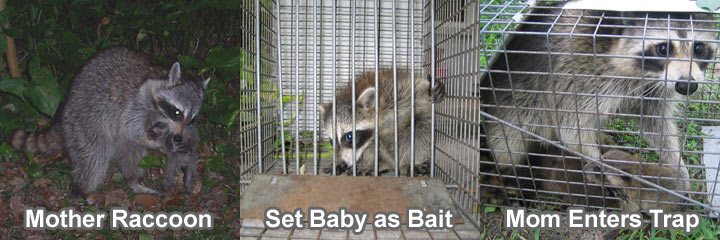
What Do I Do with the Raccoon Once I’ve Caught It? First of all, check the trap every day, or several times a day, so that you don’t leave an animal suffering in a cage for long. When handling the trap, be careful, because raccoons can reach far outside the trap bars and scratch. And don’t let your fingers enter the cage, or the raccoon will lunge and bite! Pick up and move the cage with care. Some states require that the animal be euthanized, often under laws regarding the spread of an animal that could possibly carry rabies. Many people and wildlife removal companies ignore such laws, because they don’t want to kill wildlife, just like many people ignore wildlife regulations out of ignorance or lack of concern for laws. If you do relocate the raccoon, it should be at least five miles from the capture site. Some people recommend at least ten miles. Many critters are amazingly adept at tracking their way back to a home range. If you relocate a mother raccoon with babies, the mother will bolt from the trap and run away as soon as it’s opened. Let the babies go as well, even if they are very young, and the mother raccoon will always come back for them and bring them to a new shelter. Bear in mind, this time period may be tough for her and her young, but the young stand the best chance of survival with their mother, even over a licensed wildlife rehabber.
If you want to enlist the help of a professional to trap your raccoons, I believe that most of the wildlife control operators listed on this wildlife removal directory, which includes listings for 450 US cities and towns, do a competent job. I've also compiled a list of good raccoon experts in several major US cities, including Charlotte - Fort Lauderdale - Miami - Seattle - Portland - Oakland - Los Angeles - San Diego - Phoenix - Dallas - Houston - Austin, TX - Arlington, VA - Denver - Cincinnati - Baltimore - Nassau County - Jacksonville - Orlando - Tampa - Boca Raton - Virginia Beach - Chicago. But before you hire anyone, be sure to read this guide and gain a good understanding of the matter at hand, and ask whoever you wish to hire the right questions, and be sure that they remove the baby raccoons as part of their wildlife control solution!
Wildlife Education - Information, Advice, and Techniques for the Safe Trapping of Raccoons
